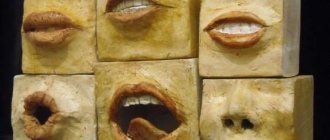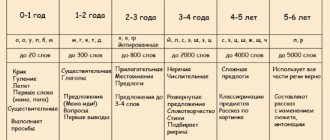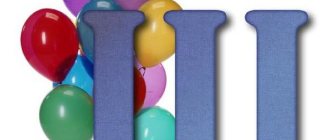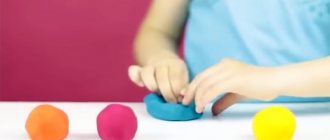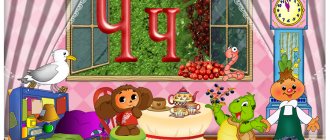Automation of the sound C in words with the help of presentations takes place in a playful way.
The sound “C” is normally formed in children by the age of 4 years. The reasons for the absence or distorted pronunciation of the “C” sound are different. But if your child does not have this sound in his speech by the age of five, then you should think about it.
Performing special exercises (articulation gymnastics) can help you pronounce this sound correctly. If this does not correct the situation, then we recommend that you seek help from a specialist.
Next, we proceed to automate the delivered sound in syllables, words, phrases, sentences, and coherent speech. All this material can be found at this link.
Since the automation process usually takes a long time, a huge amount of material is required. All this is so that the child’s interest does not fade away and he does not refuse to study.
It is for these purposes that a PRESENTATION FOR AUTOMATING THE SOUND “C” AT THE BEGINNING OF WORDS has been developed.
Articulation gymnastics for whistling sounds
1. Lip exercises.
- “Smile” - stretch your lips into a smile as much as possible. The teeth should be closed. Hold your lips in this position for several seconds. Repeat several times.
- “Tube” - the teeth are closed, the lips are pulled forward.
2. An exercise to develop an air stream - be able to forcefully blow air through your lips, folded into a tube. The air stream should be sharp and cold. Repeat several times.
- “Football” - you need to take a small piece of cotton wool. This will be the ball. Set up an improvised gate. The child must blow forcefully on the cotton wool and try to score a goal. Monitor the direction of the air stream. She should be strong, cold, lips like a tube.
3. Exercises for the tongue.
- “Let’s brush your lower teeth” - smile, open your mouth slightly, use the tip of your tongue to “brush” your lower teeth from the inside, moving your tongue from side to side.
These are games and exercises:
- “Name and repeat”;
- "Big small";
- “One is many”;
- "The fourth wheel";
- “Let’s do the math.”
These games will help not only automate the “S” sound in words, but also develop the grammatical structure of speech. Children very often make mistakes in the formation of nouns with diminutive suffixes, errors in the formation of plural nouns, in the agreement of nouns with numerals, etc.
These presentations will help you cope with this problem, and will also develop attention, thinking and memory.
Automating the “S” sound in words using presentations is a fun activity. Children will definitely like it.
This is not a boring repetition of words and phrases, but a gaming computer manual.
Speech exercises to reinforce the pronunciation of the sound “C”
Pronouncing the hard sound “S” in straight syllables
1. Pronounce or read the syllables, extending the “s” sound:
- “sa-sa-sa”; “sy-sy-sy-sy”; “su-su-su-su”; “so-so-so-so.”
- “sa-sy-so-su”; “sy-so-su-sa”; “so-su-sa-sy”; “su-sa-sy-so.”
2. Game “Memorize and repeat”:
- “sa-sa-so”; "so-sa-so"; "so-sa-ea"; “sy-sa-sy”; “sa-sy-sy”; “sa-sy-sa”; “sa-sa-sy”; “sy-so-su”; “su-ey-su.”
3. Repeat the nursery rhyme and remember it:
- Sa-sa-sa - here comes the fox.
- So-so-so - she rolls the wheel.
- Sy-sy-sy - a fox has a red tail.
- Su-su-su - we are not afraid of the fox.
Pronouncing syllables
- “So”: juice, catfish, sleep, Sonya, soda, falcon, litter, hill, barefoot, oblique, sand, sock, forest, belt, spikelet, wheel, bean, tall, sedge.
- “Sa”: himself, garden, lard, sleigh, Sasha, sugar, cod, sleigh, wasp, fox, braid, dew, bite, write, beauty, sausage, stripe, sambo, landing, mustachioed, kindergarten, write.
- “Su”: soup, bough, court, bag, vessel, dishes, carry, draw, carry, vessel.
- “Sy”: cheese, son, owl, full, scales, mustache, noses, scarf, parcel, rash, mound.
Pronunciation of words
1.With unstressed syllables:
- Salad, gardens, boot, fireworks, cash register, mass, plane, sundress, Larisa, rat, be able to, chest, souvenir, cheese, son, raw, wasps, beads, rails, hair, blond, send.
At this stage, it is recommended to use visual material, card indexes of subject pictures, and playful work techniques.
2. Pronounce the syllables correctly:
- “ska-sko-sku-sky”; “sla-slo-slu-sly”; “sma-smo-smo-smy”;
- “swa-swo-swo-swa”; “spa-spo-spo-spa”; “hundred-hundred-stu-sty.”
3. Read or say “difficult” words - with a combination of consonants:
- Pile, dump, dump, your, firmament; rolling pin, roll down, tablecloth, bench, fast, Glory, sweet, elephant, word, hearing; could, we can, wash away, dare, sheaf, again, dreams; sleep, dispute, sport, satellite, confuse, camp, steel, put, put, old man, glass, get, stand up; one hundred, table, so much, stand; tincture; chair, knock, steps, offense, deed.
Benefits of presentations:
- All children love to play on computers and all kinds of gadgets. Therefore, this type of gaming activity will definitely interest them.
- All material and pictures are understandable for children.
- In the presentation, the child will be able to switch files himself, and this is an additional game moment.
- The presentation is a very accessible educational material that does not require any costs. All you need is a computer, laptop or tablet.
This game guide also presents articulation exercises for the sound “C”. They must be carried out before the start of the lesson in order to prepare the child’s speech apparatus to pronounce the sound “C” correctly.
You will find more complete information on performing articulatory gymnastics at the dedicated link.
Presentation: “Automation of the sound “C” in words” has been developed in several versions and is divided into parts. This is done so as not to tire the child with a long lesson. And most importantly, the basic rule is observed - automation of the sound “C” occurs in stages.
It was for these purposes that presentations were developed in 4 versions:
- Automating the "S" sound at the beginning of words
- Automating the "S" sound in the middle of words
- Automation of the "S" sound at the end of words"
- Full version of the presentation (contains all three stages of automating the “C” sound)
There is only one presentation on the site: “Automation of the C sound at the beginning of words.” This version contains 22 pages on automating the “S” sound at the beginning of words.
You can also see presentations on automating the sound “C” in the middle of words, on automating the sound “C” at the end of words, the full version of the presentation. They contain 20, 17 and 61 pages respectively.
You can receive these presentations by emailing
You can also write feedback via email. You can find it at the end of each page.
In addition, in the presentation on the automation of the sound “C” you will be able to play educational games and exercises with your baby.
Sound [S].
Corrective and developmental tasks. Automation of sound in words, phrases, text. Development of coordination of movement and speech. Development of general fine and articulatory motor skills. Development of coherent speech.
Correctional and educational tasks. Promoting the development of communicative competence. Formation of skills of cooperation, mutual understanding, independence, responsibility. Formation of motivation and interest in the learning process.
Baby elephant is a traveler.
Once upon a time there lived a Little Elephant who loved to read books. One day he read that somewhere far away there is a Land of Smiles and Light. The little elephant decided to find out where she was. And he began to prepare for the journey.
The Little Elephant collected two travel bags. In the first, the Little Elephant put a table, a tablecloth, napkins, a glass, a samovar, sugar, crackers, and sausages. And secondly, gifts for friends that he will definitely make along the way.
The traveler began his journey from the north. In the north it was cold and there was no sun at all. The little elephant saw the Snow Leopard, who was sitting and sad. “This is not the Land of Light and Smiles...” thought the Little Elephant. The Baby Elephant wanted to give the Snow Leopard a little warmth and a good mood, he opened his bag and took out warm socks and a candle. Snow Leopard immediately became cheerful and decided to go with the Elephant. Soon the travelers found themselves in the desert, where they were met by the Brave Gopher. The gopher asked his friends where they were going. And then he started his plane and all the travelers flew on together. A dense forest appeared ahead. Having landed the plane, Baby Elephant, Snow Leopard and Brave Gopher went out into the clearing. The Fox was sitting under the pine tree. She was happy when she found out where her friends were going. Lisa suggested everyone get some rest. The little elephant took the table out of his bag, the Snow Leopard spread the tablecloth and laid out the napkins, the brave gopher boiled the samovar, poured tea into glasses and laid out sugar, crackers and sausages on the table. The little elephant found out that the Fox loved to draw, and gave her brushes and paints.
The travelers sat at the table and wondered where to go next, how to get to the Land of Smiles and Light? And suddenly a Wise Owl flew down to them from a tall pine tree. She looked at everyone and said, “Your journey is over. I am glad to welcome you to the Land of Smiles and Light. The friends were very surprised, and the Wise Owl continued: “Your friendship has given you light and joy!” “Hurray!” - shouted the Elephant. And they all sang together:
If a friend doesn't laugh,
Turn on the sun for him.
Turn on the sun for him
It's simple!
Questions for a fairy tale
- What is the name of the country that the Little Elephant was looking for?
What did the Baby Elephant take on his trip? Place the pictures in the bags.
We wish you success!
Setting the sound C in words, syllables and phrases
First, the child must learn to pronounce the sound [C] in isolation. There are several ways to make sounds:
1. By imitation.
Together with your child, sit in front of the mirror and show your child the correct articulation of the sound “C”. Ask the child to open his mouth, smile, spread his tongue, press the tense tip against the lower incisors and pass a “breeze” across the tongue, the sound “C” is heard.
2. By imitation with the introduction of gaming techniques:
- pump up the wheel (s-s-s);
- a cold wind is blowing (sss);
- the balloon is deflated (sss);
- blow into a bottle with a narrow neck (you'll get a s-s-s sound).
3. From reference sounds.
For the sound [S] these are the sounds [I] and [F]. The sound [I] is the same in place of formation (front-lingual), the tip of the tongue is behind the lower incisors and the same rise of the front part of the back of the tongue. The sound [F] is the same in the method of formation (slotted), a directed air stream is produced. When the child has learned to pronounce the reference sounds well, ask him to pronounce the sound [I], bring his teeth together and pass the breeze across his tongue, you get a whistle reminiscent of the sound [C].
4. Mechanical method.
Take a narrow stick (a fireplace match), a lollipop stick, and place it in the middle on the outstretched tongue, resting on the lower incisors. Lips in a smile, ask the child to bite the stick with his teeth, then smoothly blow out the air with force. The child should feel the exhaled stream of air with the back of his hand. The sound [S] is heard. Next, when this technique has been worked out, we do the same, but without a stick. The [S] sound is set.
Let's look at different types of parasigmatism.
1. The sound [S] is replaced with [F]:
Labiodental parasigmatism. The child says this: “funky” - instead of “sledge”, “pefok” - instead of “sand”, etc.
In order to begin work on producing the sound [C] in this case, you must do the following:
- develop phonemic hearing (select exercises to develop the ability to distinguish between these sounds [F] and [S]);
- perform a complex of articulatory gymnastics.
When setting a sound, you need to take into account that the child is already pronouncing this sound and pronouncing it incorrectly. With this type of substitution, the lips take part in the pronunciation of sounds.
The movements of the lips must be slowed down; you can hold them with your finger. You can even explain to the child the reason for the incorrect pronunciation of the sound. Demonstrate the correct articulation of the sound [C] and only after that proceed with sound production.
Therefore, it is better to start with the production of reference sounds, in this case with the sound [I]. When the correct position of the tongue has been practiced, ask the child to blow the wind across the tongue; if the lip movements persist, hold them with your finger. If difficulties persist in this case, use a match.
2. The sound [S] is replaced with the sound [T]:
Dental sigmatism. The child says this: “toldat” - instead of “soldiers”, “notes” - instead of “socks”, etc.
The work is carried out in the following areas:
- Development of phonemic hearing.
- Articulation gymnastics.
- Exercises to develop an air stream.
The sound [S] with dental parasigmatism can be started using the reference sounds [I] and [F] and asked to blow a “breeze” across the tongue. The sound [S] is heard. You can create the sound [C] from the sound [T], changing the method of sound formation. We ask the child to pronounce the sound [T] more and more slowly, while the child moves the tip of the tongue to the position of the sound [C], i.e. gets behind the lower incisors.
3. The sound [S] is replaced with the sound [Ш]:
Hissing parasigmatism. The child says this: “shadik” - instead of “kindergarten”, “lashtochka” - instead of “swallow”, etc. You should also work on the development of phonemic hearing, teach the child to distinguish by ear where [Ш] is pronounced and where [S] is pronounced. A number of exercises should be selected to develop the ability to distinguish these sounds.
Next we do articulation gymnastics.
When correcting hissing parasigmatism, attention should be paid to:
- The difference is in the place of articulation. When pronouncing the sound “C”, the tip of the tongue is at the lower incisors. And when pronouncing the sound “Ш”, the tongue is raised upward.
- Difference in exiting air stream. When pronouncing the sound “C”, the air stream is strong, narrow, and cold. When pronouncing the sound “Ш”, the air stream is strong, wide, and warm. Holding the child's hand near the adult's mouth, pay attention to the difference in the exhaled air stream. The child should feel this difference in thermal sensations.
4. The sound [С] is replaced by the sound [Ш]:
Hissing parasigmatism. The child says this: “shchanki” - instead of “sledge”, “lishcha” - instead of “fox”, etc.
When correcting hissing parasigmatism, you should explain the correct articulation of the sound [C] and use a match. This prevents the tongue from rising, which will lead to the correct sound [C].
After setting the sound and practicing isolated pronunciation, you need to move on to automating the sound [C] in syllables, words, phrases, etc. You always need to start with syllables, gradually complicating the task.
It is useful to perform the following breathing exercises to produce the sound [C].
For example, here are some of them:
"Trumpeter".
- Position – sitting.
- The hands are clenched into a tube; they need to be raised up.
- Exhale slowly with a loud, high-pitched sound F-F-F.
- Number of repetitions – 4-5 times.
"The porridge is boiling."
- Position – sitting.
- One hand lies on the stomach, the second on the chest.
- You need to suck in your stomach and draw air into your chest, then stick out your stomach.
- As you exhale, say F-F-F loudly.
- Number of repetitions – 3-4 times.
Exercises for the articulatory apparatus (lip activation):
- Tube. Fold your lips into a tube, as if pronouncing the sound U. Silently.
- Lip spanking. Soundlessly slap your lips, as if pronouncing the sounds P-B.
- Yawn. Open your mouth wide (silently) as when yawning and pronouncing the sound A.
Exercises for the articulatory apparatus (tongue activation):
- Pendulum. You need to alternately touch the corners of your mouth with your tongue, as if a pendulum is swinging.
- Cog. You need to make circular movements with your tongue.
- Tube. Stick out your tongue and fold it into a tube.

